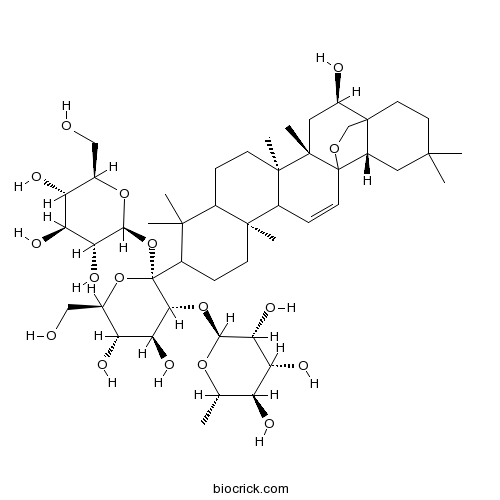InChI=1S/C48H78O17/c1-22-30(52)33(55)36(58)39(61-22)63-38-35(57)32(54)24(20-50)64-48(38,65-40-37(59)34(56)31(53)23(19-49)62-40)26-9-12-43(6)25(42(26,4)5)10-13-44(7)27(43)11-14-47-28-17-41(2,3)15-16-46(28,21-60-47)29(51)18-45(44,47)8/h11,14,22-40,49-59H,9-10,12-13,15-21H2,1-8H3/t22-,23+,24+,25?,26?,27?,28-,29+,30-,31+,32+,33+,34-,35-,36+,37+,38+,39-,40-,43-,44+,45-,46?,47?,48+/m0/s1
Saikosaponin C (SSC) is one of the saikosaponins that are consisted in a Chinese herb, Radix Bupleuri, it yields a potent effect on inducing human umbilical vein endothelial cells (HUVECs) viability and growth, also induces endothelial cells migration and capillary tube formation. [1]
Saikosaponin C can inhibit lipopolysaccharide-induced apoptosis by suppressing caspase-3 activation and subsequent degradation of focal adhesion kinase in human umbilical vein endothelial cells.[2]
Saikosaponin C seems to have beneficial effects on cellular tau function, it accelerates nerve growth factor (NGF)-mediated neurite outgrowth and increases the assembly of microtubules (MT) and synaptic marker proteins such as synaptophysin and PSD-95, suggests SSc might be a novel therapeutic tool for treating human AD and other neurodegenerative diseases. [3]
Saikosaponin C can cure liver disease.[4]
English website: Saikosaponin C
Japanese website: Saikosaponin C
Chinese website: Saikosaponin C
[1] Shyu K G, Tsai S C, Wang B W, et al. Life Sci, 2004, 76(7):813-26.
[2] Lee T H, Chang J, Kim B M. Biochem Bioph Res Co, 2014, 445(3):615-21.
[3] Tae Ho Lee †, Sung Ha Park †, You M H, et al. J Neurochem, 2015, 136(6):1232-45.
[4] Chen Y C, Wang H M, Niu Q X, et al. Molecules, 2016, 21(2):153.
[5] Wang X D, Zhang Z W, Sun X M, et al. J Pharm Practice, 2001, 19(05):298-300.



